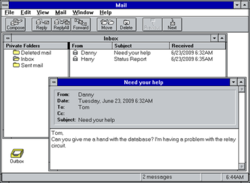Microsoft Mail

Microsoft Mail Client for Windows NT
|
|
| Developer(s) | Microsoft |
|---|---|
| Initial release | 1991 |
| Stable release |
3.5
|
| Operating system | Microsoft Windows, Classic Mac OS, OS/2, MS-DOS, IBM PC DOS |
| Platform | Most file server systems, including Novell and LAN Manager |
| Available in | English, French, German, Japanese, others |
| Type | |
| License | Proprietary software |
Microsoft Mail (or MSMail) was the name given to several early Microsoft e-mail products for local area networks, primarily two architectures: one for Macintosh networks, and one for PC architecture-based LANs. All were eventually replaced by the Exchange and Outlook product lines.
The first Microsoft Mail product was introduced in 1988 for AppleTalk Networks. It was based on InterMail, a product that Microsoft purchased and updated. An MS-DOS client was added for PCs on AppleTalk networks. It was later sold off to become Quarterdeck Mail, then Star Nine Mail, and has long since been discontinued.
The second Microsoft Mail product, Microsoft Mail for PC Networks v2.1, was introduced in 1991. It was based on Network Courier, a LAN email system produced by Consumers Software of Vancouver BC, which Microsoft had purchased. Following the initial 1991 rebranding release, Microsoft issued its first major update as Version 3.0 in 1992. This version included Microsoft's first Global Address Book technology and first networked scheduling application, Microsoft Schedule+.
Versions 3.0 through 3.5 included email clients for MS-DOS, OS/2 1.31, Mac OS, Windows (both 16 and 32-bit), a separate Windows for Workgroups Mail client, and a DOS-based Remote Client for use over pre-/pre- dialup modem connections. A stripped-down version of the PC-based server, Microsoft Mail for PC Networks, was included in Windows 95 and Windows NT 4.0. The last version based on this architecture was 3.5; afterwards, it was replaced by Microsoft Exchange Server, which started with version 4.0.
The client software was also named Microsoft Mail, and was included in some older versions of Microsoft Office such as version 4.x. The original "Inbox" (Exchange client or Windows Messaging) of Windows 95 also had the capability to connect to an MS Mail server.
...
Wikipedia
